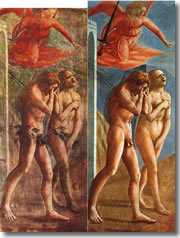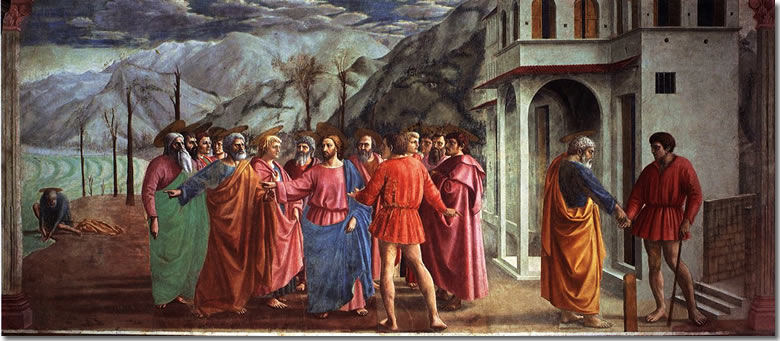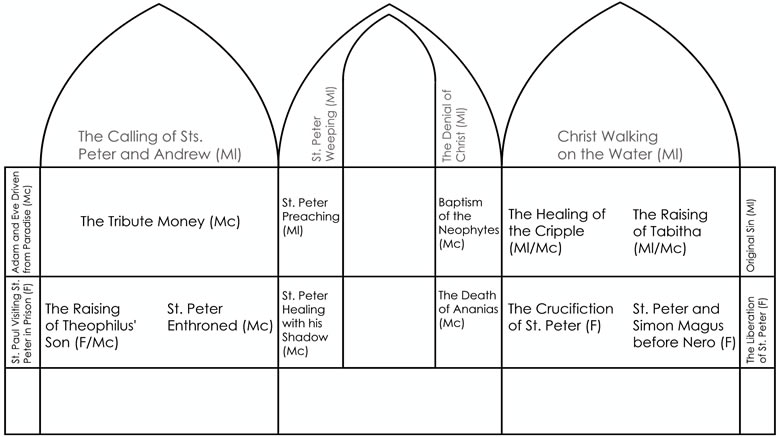
Masaccio's Expulsion from the Garden of Eden in the Brancacci Chapel - Both before and after the 1980s cleaning that removed the soot, varnishes, and overpainted "modesty vines" of past "restorations."Try to ignore the rough non-facade and the uninspired baroque architecture of the interior (though the trompe-l'oeil ceiling is nice enough, as is the Chapel of Sant'Andrea Corsini on the left transept, designed by Pier Francesco Silvani, its ceiling frescoed by Luca Giordano).
You're here to see the 15th century Brancacci Chapel covered in frescoes by Masolino, Filippino Lippi, and most famously Masaccio, the Giotto of his generation.
Luckily for generations of art fans—including a young art student named Michelangelo, who once came with his sculpture class to study what were to him the great Old Masters—the 1771 fire that destroyed most of the original 13th century church attached to a former Carmelite convent did spare the back right corner of the church... which just so happened to contain the Brancacci Chapel.

The Brancacci Chapel. (Photo by Sailko)In 1425, Brancacci commissioned the chapel to be slathered in frescoes by Masolino ("Little Tom"), who took on the job along with his far-more talented young assistant Masaccio ("Ugly Tom").
They worked on the frescoes together on and off until 1428, when Masolino decamped for Rome and Masaccio took over.
The theme was "The Life of St. Peter" (bookended by some Adam and Eve scenes), and it is quite clear there is more than one artist at work here.
Masolino's sweet, lithe figures dance across the scenes delicately. They're pretty, and well-crafted, and not much else.
Masaccio's brooding, solid characters stride boldly along in landscapes rendered with perfect perspective, fully fleshed out and expertly executed, Masaccio employed a early form of chiaroscuro (the interplay of intense light and shadow) to heighten the sense of realism and depth and ingenious storytelling techniques to ties the scenes together and the panels to one another.

Masolino's Temptation of Adam and Eve
Masolino's doomed couple in the Temptation of Adam and Eve are posed against the wall, eyes open but vacant. Eve nonchalantly leans against the Tree of Knowledge with one arm draped around it (much like the female-headed serpent wound around the trunk), about to offer her bland husband a piece of fruit. He scratches his chest.
Masaccio's Adam and Eve, being expelled from the Garden of Eden, wail in their anguish. Eve's face turns blindly toward the heavens, her hands failing to cover her nakedness, her mouth a cruel open slash crying to an unforgiving God. Burly-chested (but oddly short-armed) Adam simply buries his face in his hands and weeps uncontrollably.
Excellent restorations in the late 1980s removed prudish overpaintings of vines done centuries ago that covered Adam's quite, er, prominent penis which seems almost to lead the way out of Paradise.
The vines may have satisfied later ideals of modesty, but they also deadened the power of the piece. Their cruel nakedness makes the cursed first couple appear much more vulnerable, their punishment much more severe.
There's no time to go into the details on all the frescoes, so here is just a list of those by Masaccio:
Yes, Masaccio only did most of this last fresco. It (and the remaining murals) was finished off 50 years later by yet another artist...

Actually, there were three artists who worked the fresco cycle. The frescoes were left incomplete when Masaccio followed Masolino to Rome in the middle of 1428.
Filippino Lippi—son of painter Filippo Lippi (who was once a monk in this very convent) and protégé of his father's own star pupil, Botticelli—was hired 50 years later to complete the cycle to Masaccio's designs.
He did some of the figures in the St. Peter Enthroned on the left wall, the St. Peter in Prison Visited by St. Paul to the left of it on the entrance arch, and, along the the bottom of right wall, the long Crucifixion of St. Peter and Liberation of St. Peter from Prison next to it.
Lippi was hired because (a) the moneybags behind the commission, Felice di Michele Brancacci, was exiled from Florence in 1432 for taking sides against the powerful Medici clan, and (b) neither Masolino nor Masaccio had ever returned to finish the job.
Masolino remained a sought-after artist and ended up moving from job to job and town to town, drifting from Rome to Todi to Castiglione Olona, where he died in 1447 at the age of 64. (He was quite the traveler; part of the reason Masaccio did so much of the Brancacci commission is that Masolino spent two years in Hungary during the middle of the job.)
Masaccio—perhaps the greatest talent of his age, the man whose works inspired Michelangelo, Raphael, Leonardo Da Vinci, and legions of lesser artists down through the ages—died of a fever in Rome within months of leaving Florence.
He was 26 years old.
Here is a plan of the Brancacci Chapel frescoes' layout. Works labeled (Mc) are by Masaccio, (Ml) by Masolino, and (F) by Filippino Lippi:

Share this page
Search ReidsItaly.com
Piazza del Carmine 14
tel. +39-055-238-2195
museicivicifiorentini.comune.fi.it
Tickets: Select Italy
Chapel open Mon and Wed–Sat 10am–5pm, Sun 1–5pm
€6.00
Tickets: Select Italy
With Firenze Card: Free
Bus: D; 11, 36
Hop-on/hop-off: Tasso (A), Piazza Tasso (C)